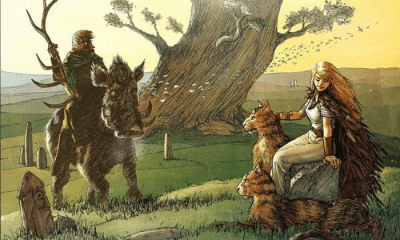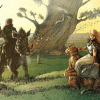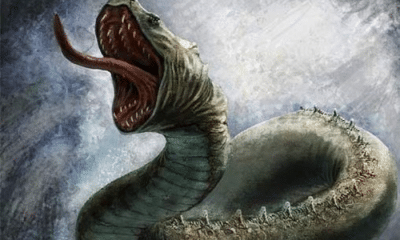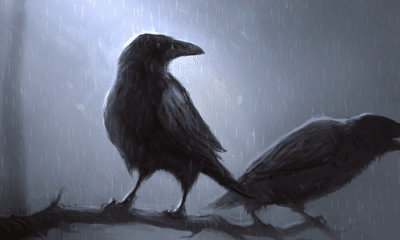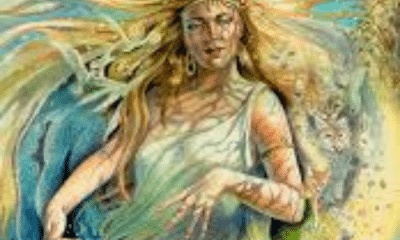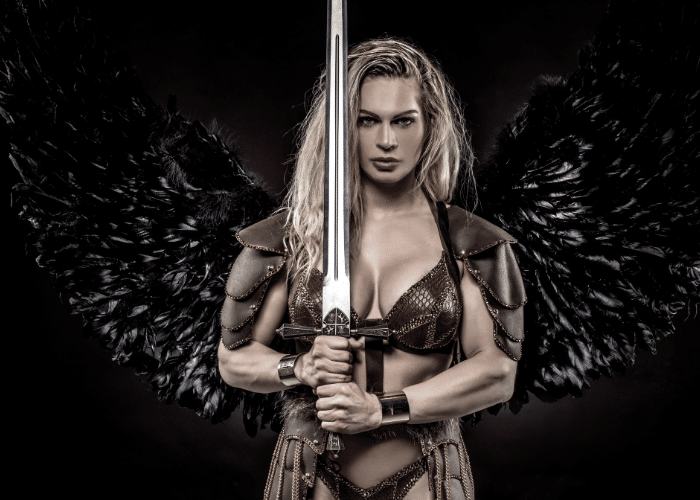
Norse
Who Were the Valkyries in Norse Mythology?
Who Were the Valkyries in Norse Mythology?
The image of the Valkyrie is one of the most enduring of the Norse Era. From contemporary art and literature to later operas, the goddesses of the battlefield have been a popular part of the mythology for centuries.
The Valkyries are typically depicted as fearsome but beautiful warrior women. They fly above the battlefield and swoop down to choose the bravest, most noble warriors at the moment of death.
These chosen fighters are then taken to Valhalla, the paradise of those who died in battle, where they will fight and feast until Ragnarok.
This popular image of the Valkyries was certainly known during the Viking Age, but was there more to these goddesses of the battlefield than just their selection of the slain?
The Valkyries on the Battlefield
The Valkyries are most well-known for the role they played in battle.
Their name comes from two Old Norse words, valr referring to those who died in battle and kjosa meaning “to choose.” They were the “choosers of the slain.”
The Valkyries appeared at the scene of battle. While ancient sources do not entirely agree on whether they were responsible for deaths themselves or not, they did agree that those who showed exceptional courage and strength would be noticed by these warrior women.
Those who fought and died well would be chosen by the Valkyries for a place in Valhalla. They would join the Einherjar, the warriors who fought and feasted each day in Odin’s hall.
While the primary role of the Valkyries was to choose which of the dead men went to Valhalla, some stories claimed that they had other roles on the battlefield as well.
For example, in the story of the heroic king Helgi Hjorvardsson, he meets a beautiful Valkyrie called Svava. She says that she had, unbeknownst to him, protected him many times in battle.
In the story of another hero, Sigurd, a Valkyrie is found unconscious on a battlefield. She says that she was given a sleeping potion by Odin as punishment for killing a man he wished to live.
The implication in this Valkyrie’s story is that the warrior goddesses not only chose men once they had died, but also that they singled out at least some men for death on their own.
The idea of the Valkyries somehow influencing fate is referenced in more than one source.
One name that is frequently given for one of the Valkyries, for example, Skuld, references fate. One source even said that she was the “youngest of the Norns,” the goddesses who wove the threads of fate beneath Yggdrasil’s roots.
It would seem, therefore, that some people believed that the Valkyries played a far more active role in fighting than just ferrying souls to Valhalla. They could both protect and kill human warriors based on Odin’s wishes or the predetermined threads of fate.
Who Did They Obey?
The Valkyries were usually described as servants of Odin. They are linked to the chief of the gods in many legends and poems.
One name that was sometimes given to them, for example, was “Odin’s maids.” In one poem, a seeress called them the “ladies of the War Lord.”
Odin’s hall, Valhalla, was said to be the place where those who died in battle went in the afterlife. To be selected by the Valkyries for this fate was the highest honor a Viking Age man could aspire to.
While the Valkyries were closely connected to Odin and Valhalla, however, some interpretations of Norse poems have come to the conclusion that they may have served another deity as well.
Freya, the goddess of beauty and magic, was also a goddess of war. While this aspect of her character is less well-remembered today, it was referenced several times in Norse poems and sagas.
According to some accounts, Odin was not the only god who took fallen warriors to the afterlife. Freya’s field, Folkvangr, also welcomed many fighting men.
In the Prose Edda, 13th century writer Snorri Sturluson even said that it was Freya, instead of Odin, who had the first choice of men who died in battle. Only after she chose her half of the best fighting men would the remainder join the Einherjar in Valhalla.
While Folkvangr does not hold as prominent of a place in the popular imagination, therefore, it is likely that the warriors there were just as renowned as those who were sent to Odin. And it seems likely that they were chosen in the same way.
Based on accounts of Freya’s choice after battle, some scholars believe that she may have been thought of as the leader of the Valkyries. Thus, she had the first choice of warriors and the remainder were taken to Valhalla.
This idea, if it existed, was likely not universal. Some believe that two warrior traditions may have existed in which one group followed Odin as their chief god and another swore to Freya.
Unfortunately, the exact nature of Freya’s role as a goddess of war is unclear based on surviving evidence. The account of her as a chooser of the slain, however, shows that Freya may have been a Valkyrie in her own right.
The Valkyries Outside of Battle
The popular image of the Valkyries is of their role in battle. Outside of war, however, they were also said to have performed a number of functions.
Their place in the afterlife of the Einherjar did not end when they brought the warriors to Valhalla. In fact, they were present in Odin’s hall every day.
When not in the midst of batter, the Valkyries served Odin and the men of Valhalla. They are described in many texts in their duties as cupbearers, serving feasts, and preparing the hall for new arrivals.
What kind of a dream is it,’ said Óðinn,
in which just before daybreak,
I thought I cleared Valhǫll,
for coming of slain men?
I waked the Einherjar,
bade valkyries rise up,
to strew the bench,
and scour the beakers,
wine to carry,
as for a king’s coming,
here to me I expect
heroes’ coming from the world,
certain great ones,
so glad is my heart.
-Eiriksmál (trans. Finlay)
This portrayal of the Valkyries is also common in art from the period.
Small amulets portraying women carrying drinking vessels or horns have been found at Viking Age sites, especially in graves. These images are widely interpreted as being representations of the Valkyries, particularly since similar female figures have been found that carry weapons and shields.
Archaeologists believe that such amulets were placed in graves to provide protection for the deceased. As in the poems, the images of the Valkyries could protect the fallen and help guide them to the afterlife.
Some legends also claimed that the Valkyries could play an important role among the living.
Several sagas that tell the stories of great kings and heroes feature Valkyries. While they are sometimes seen in battle, very often these female characters become the wives and mothers of great men.
Names of the Warriors
The heroes and kings who married the Valkyries were not necessarily marrying into a family of gods.
The Valkyries are often called goddesses, but their true lineage was somewhat more complex.
While the Norse gods were typically divided into two known pantheons, the Aesir and the Vanir, the goddesses were more complex. Not all belonged to these two groups.
A few, like Freya, were given a place in one of the two pantheons. Others were said to be elves, jotnar, or other supernatural races.
The same was true for the Valkyries. A few were called jotnar, sometimes they were elves, and one may have been the daughter of Thor.
A few of them were even described as particularly beautiful human women, usually young princesses. Even they, however, fell under the heading of asynjur, or “goddesses.”
While some texts claim there were twenty-nine Valkyries, others named only a handful. A few later sources even claimed that there were countless Valkyries that acted like the modern idea of a guardian angel or personal spirit.
While the lists of Valkyries were never in total agreement, several names occurred in many sources. These included:
- Skuld: One of six Valkyries named by the seeress Odin consults in Hel, her name meant either “Debt” or “Future.”
- Skogul: Her name translates as “Shaker.” She was mentioned in several sources.
- Gunnr: Meaning “War,” her name is now a masculine one in many European languages.
- Hildr: This Valkyrie’s name, meaning “Battle,” lived on as the name Hilda. She is also known as Brynhildr, appearing in many legends.
- Gondul: Likely referencing a type of magic, her name translates as “Wand Wielder.”
- Geirskogul: The last of the six named by the seeress and in other sources, she was the “Spear Shaker.”
- Hrist: Mentioned by Odin in the Poetic Edda, her name also meant “Shaker.”
- Mist: Her name translates as “Cloud.”
- Skeggjold: She was named by Odin as one of the Valkyries who served at Valhalla. Her name meant “Axe Age.”
- Thrud: This name meant “Power.” The same name is sometimes given to Thor’s daughter.
- Hlokk: A general word for noise, hlokk often specifically referred to the din of battle.
- Herfjottar: Her name meant “Host Fetter.”
- Goll: Mentioned as a servant of the Einherjar, her name meant “Tumult.”
- Geirahold: This name translates as “Spear Fight.”
- Randgrid and Radgrid: Mentioned in the same list, these two similar names referred to types of truces.
- Reginleif: Her name meant a third type of truce.
- Svava: The “Sleep Maker” was the daughter of a human king who married King Helgi of Norway.
- Sigrun: Sometimes said to be the reincarnation of Svava, her name meant “Victory Rune.”
- Kara: In the third poem relating the story of Helgi Hjorvardsson, “The Wild One” was a reincarnation of Sigrun.
- Sigrdrifa: In the story of the hero Sigurd, she was a Valkyrie who was punished by Odin for slaying a warrior he wished to live.
- Svipul: Meaning “Changeable,” her name was both a term for battle and an allusion to Fate.
- Rota: Her name meant “Sleet,” and she is mentioned in several poems.
The fact that many of these names can be found in many separate poems does not necessarily mean that they were fully-formed characters.
While some Valkyries, such as Brynhildr and Sigrun, had individual roles in specific legends, others are found only on lists of names. As seen in the translations of these names, they were often descriptive.
The names of most Valkyries can be translated directly as nouns that describe aspects of their function. Gunnr, for example, simply means “War” and Hildr meant “Battle.”
These repeated names could be based on the fact that their meanings were so literal rather than on a concept of the Valkyries as fully-formed characters. Instead, some scholars view them as similar to the Greek daimones who were personifications of a function with little individual personality or characterization.
As personifications of the battlefield, their names were simply the words used to describe different aspects of fighting.
Origins of the Valkyries
The names of the Valkyries, however, are believed by many to have been relatively late additions to Norse mythology. Some scholars think that the names were largely the result of poetic creativity.
The original Valkyries, they think, were much more intimidating figures than the beautiful maidens described in later works.
One interpretation that has been put forth for the development of the Valkyries is that they originally had a more demonic form.
Valhalla, some believed, was not always a type of paradise. While the daily fights that took place there were described in later works as a source of joy and exhilaration for the Einherjar, Valhalla may have once been a place of endless fighting without the feasts that made it pleasant.
In this tradition, the Valkyries may have been more menacing than they were depicted in later years. Rather than taking the valiant to a place of reward and renown, they dragged the dying to a place where they would never know peace again.
Even in later years, the Valkyries were sometimes associated with the more negative aspects of their domain. They were often depicted with ravens, for example, who were carrion birds that often scavenged the bodies left behind after a battle.
And although most were likely added later, the names of the Valkyries also reflect the brutality of war rather than ideas of reward or valor.
As the mythology developed and evolved, however, the view of Valhalla changed. With it changed the ideas of the type of beings associated with Odin’s hall.
As the Valkyries became more positive figures, they also became more human. The stories of love affairs with beautiful Valkyrie princesses were likely among the last legends added to their mythology.
This explanation would explain some seemingly contradictory mentions of the Valkyries made in sources other than the well-known poems.
One runic inscription, for example, describes a Valkyrie as an “evil woman” who must be kept at bay. Some sources also seemed to see the Valkyries as Fury-like beings who would target men out of vengeance or spite.
The Valkyries also seem to have been closely related to a group of spirits called the Idisi or disir. These beings, who were also generally depicted in female form, controlled fate.
The Idisi took their name from a term for a wise woman, or a woman who used magic. Like the Valkyries, they were often named as Norns, the goddesses who created fate, although they had a more personal role.
The Valkyries and Idisi likely developed from the same source, a magical female being that was associated with fate and magic. Eventually, the Valkyries came to be associated specifically with battle while the Idisi had a more generalized domain.
They may have even reflected two distinct types of magic. The Valkyries, affiliated with Odin, represented battle magic while the Idisi remained linked to seidr, the magic of fate.
Warrior Women?
The popular image of the Valkyries has become intertwined with another legendary type of woman from the Viking Age, the shield maidens.
Although recent archaeological finds have shown that women were sometimes buried with the grave goods associated with warriors, the legendary shield maidens are still dismissed by most historians. They cite a lack of evidence for the existence of any significant number of known female warriors.
A few references made in Norse texts gave rise to the popular belief in the warrior women, however. And the image of the Valkyries helped to strengthen it.
Some proponents of the idea that Viking Age women fought alongside male warriors have pointed to the prominence of the Valkyries as evidence that women were associated with war in the culture. Opponents, however, have pointed out that female warrior goddesses existed in cultures such as ancient Greece that had no tradition of women participating in battle.
Those who believe the shield maidens existed, however, also sometimes put forward the idea that at least images of the Valkyries have been misidentified.
Based on the legends of the Valkyries, images of women with the tools of warfare are commonly identified as goddesses. It is possible, however, that female figures holding shields or spears could have represented the real-world counterparts of these mythical characters.
Historians have also looked to other cultures in the region for evidence. While some cultures had female goddesses without the existence of women on the battlefield, other cultures appear to have functioned differently.
Some Celtic and British traditions also included fighting women. Unlike the Norse, there is also evidence of their existence from written records, such as descriptions left by the Romans. While these women were in a minority, at least some female warriors were known in Europe in the ancient past.
The existence of women warriors in Viking Age culture has been debated by historians for many years. The Valkyries have been taken as evidence both for and against the idea that women took part in the battles and raids of Viking culture.
The Valkyries: Battlefield Goddesses
In Norse mythology and folklore, the Valkyries were goddesses of war. They were said to fly over battlefields, choosing the strongest and most valiant of the dead to join the warriors of Valhalla.
Odin’s famous hall, however, was not the only destination for such honored dead. Freya had the first choice of warriors for her own home, leading some to believe that she was the leader of the Valkyries.
In Valhalla, these goddesses also acted as cupbearers and serving women for the Einherjar warriors. They are often depicted with cups and ale horns.
In some legends, the Valkyries appeared to human heroes and kings. They sometimes married these characters and became the ancestors of later rulers.
Like other goddesses, the Valkyries did not belong specifically to any single pantheon. Their numbers included jotnar, elves, and even human princesses in addition to younger members of the Aesir and Vanir groups.
Many historians believe that the Valkyries originated as more menacing figures who represented a negative fate. As the concept of Valhalla developed into a paradise, however, the Valkyries became warrior spirits who brought the promise of glory in the afterlife.


